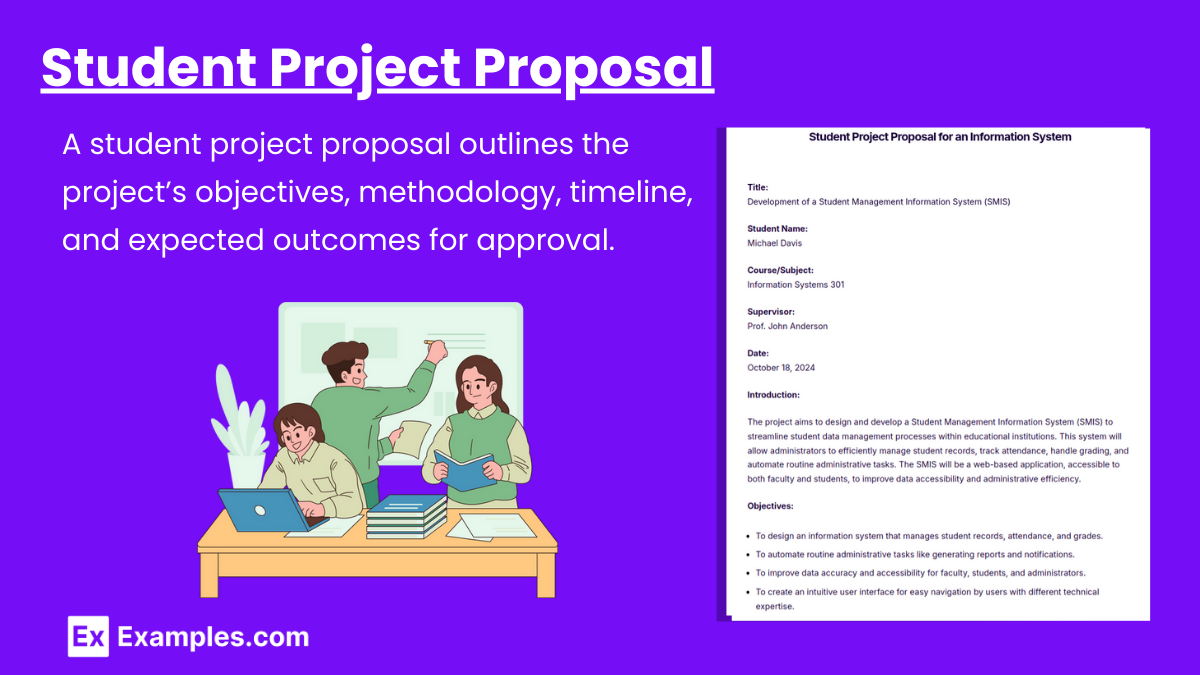10+ Student Project Proposal Examples to Download
A student project proposal is a formal document that outlines the objectives, methodology, and expected outcomes of a proposed project. It serves as a roadmap, helping the student plan their work while also providing an overview for supervisors or evaluators. This proposal identifies a specific problem or opportunity and presents a solution, detailing how the project will be executed. Through this document, students demonstrate their understanding of the topic and their ability to carry out research or practical tasks within a defined scope and timeline.
What is a Student Project Proposal?
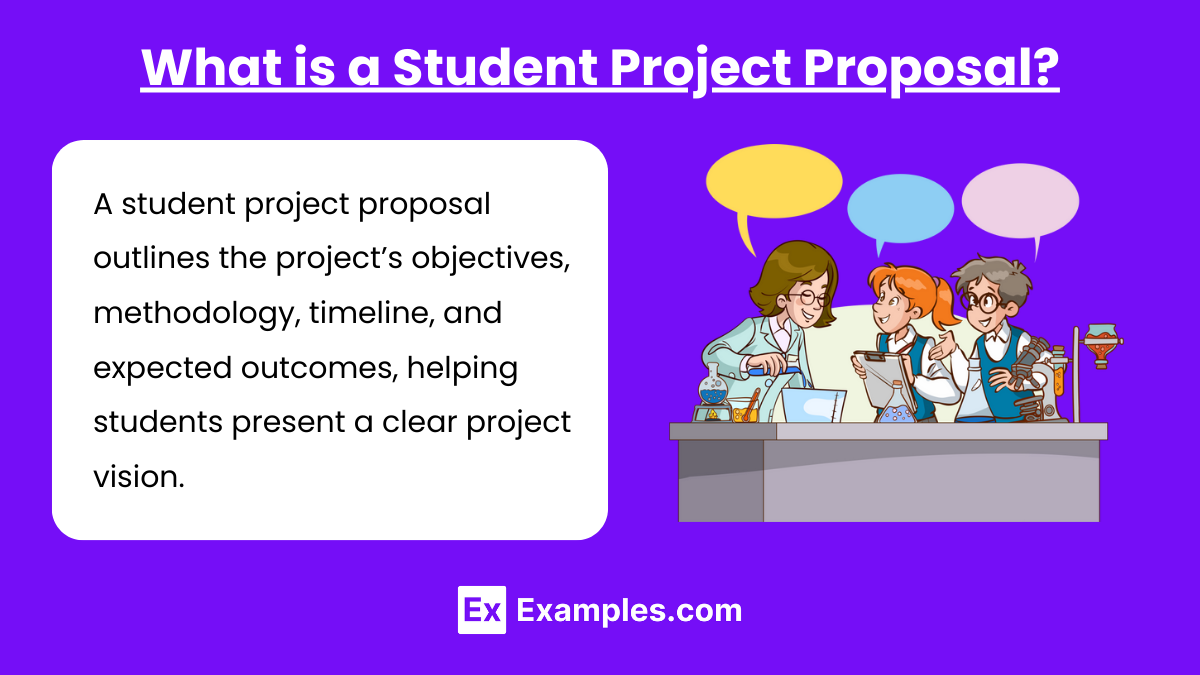
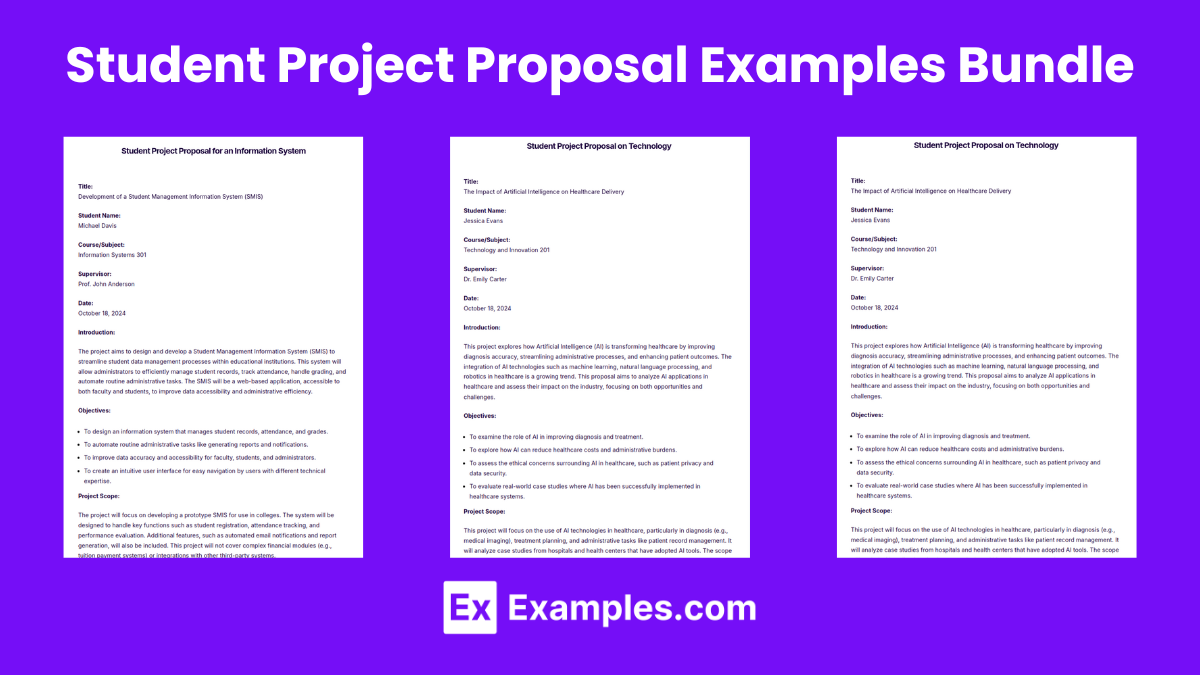
Download Student Project Profile Examples Bundle
Student Project Proposal Format
Title Page
Project title
Student’s name
Course/subject
Supervisor’s name
Date
Introduction
Brief overview of the project
Purpose and significance of the project
Objectives
Clear goals of the project
What the project aims to achieve
Project Scope
Boundaries of the project
Specific areas to be covered
Methodology
Step-by-step plan for how the project will be carried out
Research methods, materials, and tools to be used
Timeline
Project milestones
Deadlines for each phase
Resources Needed
List of materials, tools, or equipment required
Budget (if applicable)
Expected Outcomes
Anticipated results or findings
Potential impact of the project
Conclusion
Summary of the project’s importance and feasibility
References
List of sources consulted (if required)
Student Project Proposal Example
Title:
The Impact of Renewable Energy on Reducing Carbon EmissionsStudent Name:
Emily JohnsonCourse/Subject:
Environmental ScienceSupervisor:
Dr. Robert SmithDate:
October 20, 2024Introduction:
This project aims to explore how renewable energy sources like solar, wind, and hydropower contribute to reducing carbon emissions. The project focuses on the environmental benefits of transitioning from fossil fuels to renewable energy. The significance lies in addressing global warming and climate change issues.
Objectives:
- To examine the types of renewable energy sources available.
- To analyze the reduction in carbon emissions achieved through renewable energy.
- To highlight case studies from countries that have adopted renewable energy.
Project Scope:
This study will cover solar, wind, and hydropower energy sources. It will analyze data from the past decade to understand their impact on carbon emissions reduction. Fossil fuels and nuclear energy will not be included in the scope.
Methodology:
- Research: Data will be collected from scientific journals, government reports, and environmental agencies.
- Case Studies: Examine renewable energy use in countries like Germany, Denmark, and Costa Rica.
- Data Analysis: Compare carbon emission levels before and after the adoption of renewable energy.
Timeline:
- Week 1–2: Literature review and data collection
- Week 3: Analyze case studies
- Week 4: Draft report
- Week 5: Submit final project proposal
Resources Needed:
- Access to online databases (JSTOR, ScienceDirect)
- Microsoft Excel for data analysis
- Interview with an environmental expert (if possible)
Expected Outcomes:
This project will demonstrate the positive impact renewable energy has on reducing carbon emissions. It will provide valuable insights into how renewable energy can be a key solution to combating climate change and suggest ways for governments to improve renewable energy adoption.
Conclusion:
This project is important in understanding the future of energy production and its role in environmental sustainability. The findings will help build awareness about the potential of renewable energy in combating climate change.
References:
- United Nations Environmental Programme (UNEP)
- International Renewable Energy Agency (IRENA)
- IPCC Climate Change Reports
Student Project Proposal for an Information System
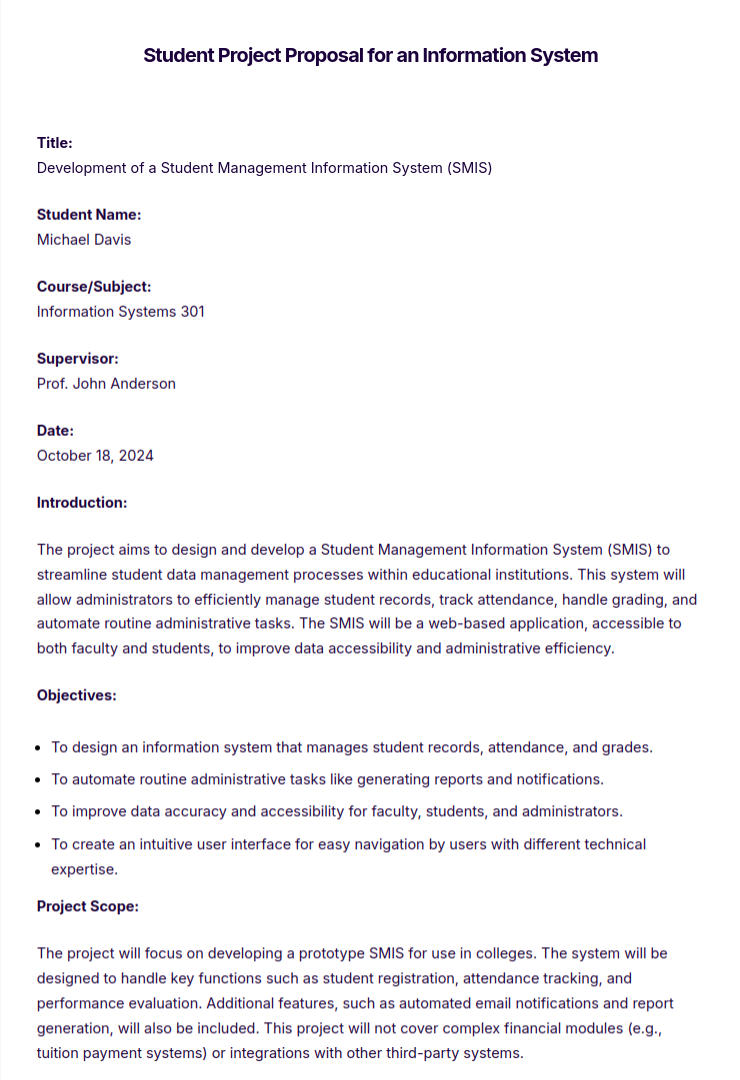
Student Project Proposal on Technology
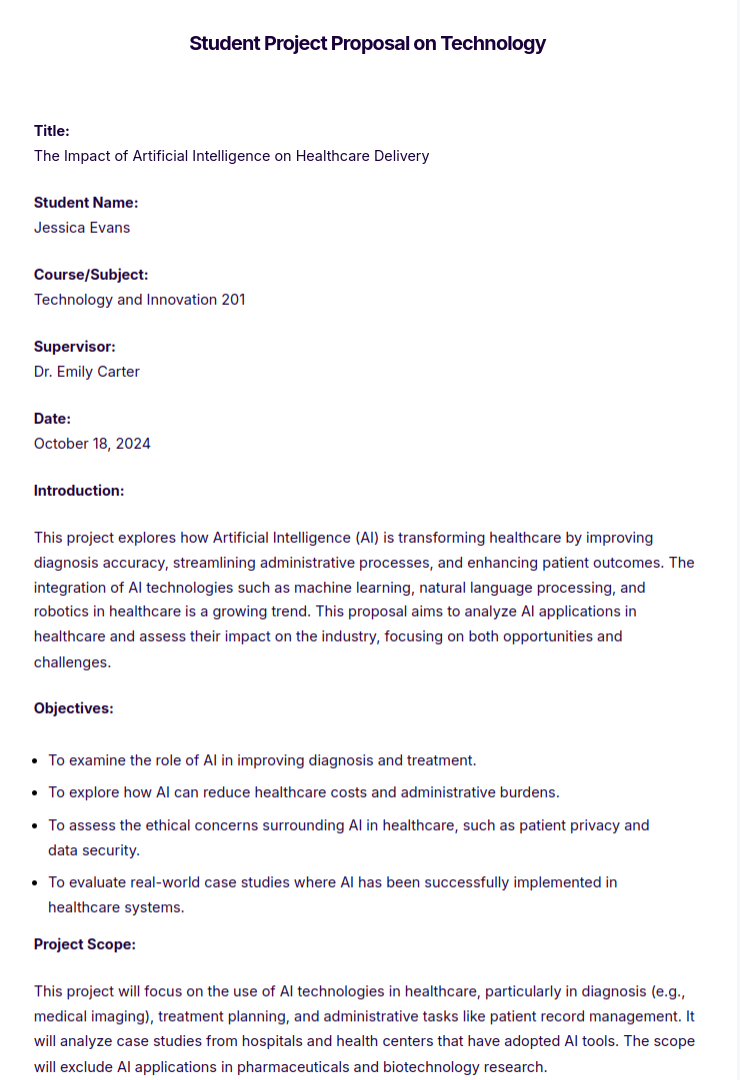
Project Proposal for a College Student

More Student Project Proposal Examples and Samples
- Student Project Proposal on Health Issues
- student project proposal on youth development
- Student Project Proposal Ideas to Improve the School
- Student Project Proposal Ideas for the Philippines
Student Project Proposal Examples and Templates
As a student, you may be immersed or be involved in the development of different kinds of proposals throughout your academic life. There are research project proposal examples, academic event management proposals, and other kinds of student proposals that are necessary for you to either pass a subject, be accepted in an educational organization or simply get a grade percentage for a project.
Creating a student project proposal from scratch can be hard especially if you are given a deadline. With the help of your basic knowledge with project proposal writing and the usage of relevant references, it is for sure that it will be easier for you to make the student project proposal that you are tasked to do. If you want to have helpful references when writing a particular student project proposal, you can select from several student project proposal examples in PDF that are available for download in this post.
Sample Project Proposal Template
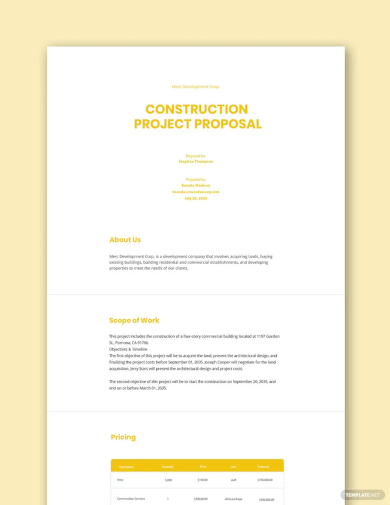
Project Proposal Outline Template
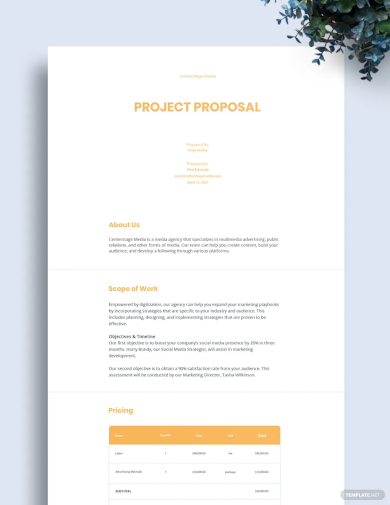
School Project Proposal Template
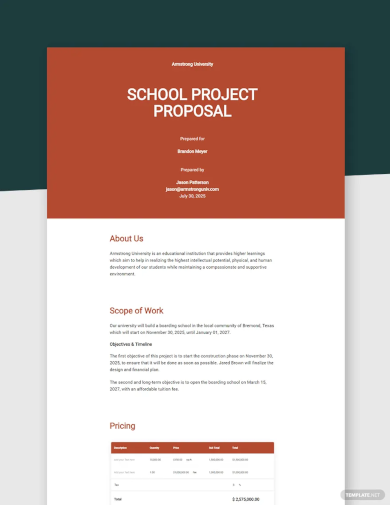
College Project Proposal Template
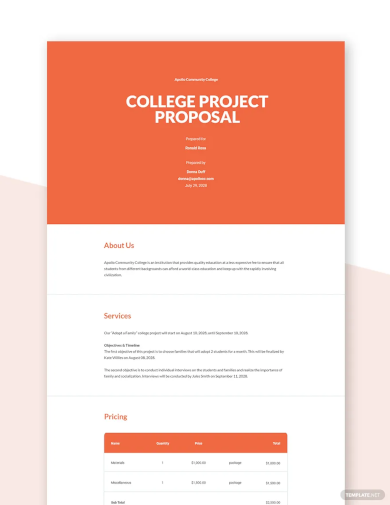
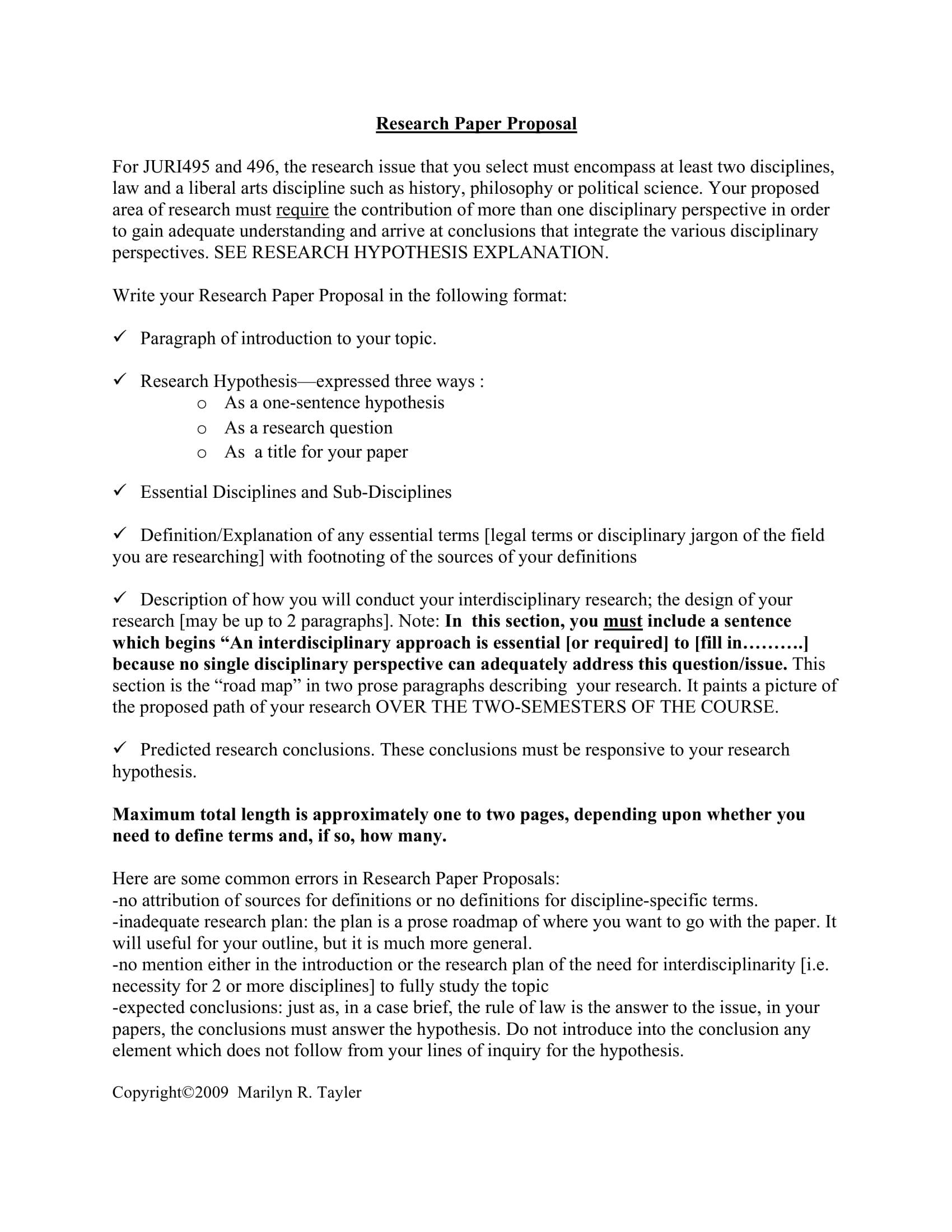
How to Prepare for Student Project Proposal Writing
Your course work as a student can specify or direct the kind of project proposal that you need to develop. There are students who need to create a multimedia project proposal and there are some that are required to provide a project proposal with a subject that is relevant to their area of study. Listed below are some of the things that you can follow to properly and fully prepare for the creation of a student project proposal.
- Know how to create a cover letter. You need to come up with a strong and impressive cover letter as it will help you to present the project proposal convincingly. This can also allow you to formally state your objective to get the panel’s consideration with regards to the project that you would like to materialize. However, keep in mind that not all academic institutions require a student project proposal cover letter. Just in case it is necessary, then knowing how to develop one can be handy. You may also see simple proposal formats.
- Even before coming up with a proposal, you need to have a goal in mind. In the planning processes of the project that you are proposing as a student, you must be guided by an objective and a vision. With this, you can align all the things and processes that can help you make the project proposal a success.
- Ensure that you will come up with a brief and direct-to-the-point proposal name. Look into existing examples of student project proposals so you can easily have an idea of what the title page looks like and how proposals are presented by other students. You may also see business proposal letters.
- List all the resources or reliable sources of data that you can get, put together, and present in the student project proposal. It will be great if your proposal will be backed up by previous studies, facts, and figures that can strengthen the necessity for the project proposal to be approved.
- Come up with a procedure that you will follow both for data gathering, information assessment, and results in the evaluation. Since you are still in the process of proposing the project, expect that your initial procedures and methods will change depending on the development of the project planning and execution phases. You may also see service proposals.
- Have a timeline that can showcase the attainability of the student project considering time measures. This will also give an idea of the time frames where particular project activities can be expected to take place. You may also see request proposals.
Types of Project Proposals
Project proposals come in various types depending on the purpose, scope, and intended audience. Each type is designed to meet specific goals and address particular needs. Here are the most common types of project proposals:
- Solicited Project Proposal: A solicited proposal is submitted in response to a request for proposals (RFP) issued by a client, government agency, or organization. The proposal must meet the specific requirements outlined in the RFP and compete with others for selection.
- Unsolicited Project Proposal: An unsolicited proposal is submitted without an official request or RFP. It is often initiated by the proposer to offer solutions or ideas that could benefit a client or organization. These proposals are generally more flexible but need to persuade the recipient to consider the project.
- Continuation Project Proposal: A continuation proposal is submitted to extend or renew funding for a previously approved project. It provides updates on the progress, results, and any changes needed to continue the project, ensuring that the initial objectives are still being met.
- Renewal Project Proposal: A renewal proposal is used to request new funding or an extension after a project’s funding period has ended. Unlike continuation proposals, renewal proposals often reintroduce the project with updated goals, justifying why the project should continue.
- Supplemental Project Proposal: A supplemental proposal requests additional resources or funding for a project that is already in progress. It is used when the original budget proves insufficient, or when unforeseen circumstances arise that require extra support.
How to Write a Project Proposal?
Writing a project proposal involves presenting your project idea clearly and effectively to gain approval or support. Here’s a step-by-step guide on how to write a well-structured project proposal:
Title Page
Include a clear, concise title that reflects the nature of your project. The title page should also include:
Project title
Your name or team members’ names
Organization or institution (if applicable)
Date of submissionIntroduction
The introduction provides an overview of your project. It should explain the background and significance of your project, including the problem it addresses.
What to Include:
Brief description of the project
Context or background information
The problem or opportunity your project will address
The significance of the project (Why is it important?)Project Objectives
Clearly define the objectives of the project. Objectives describe what you aim to achieve and should be specific, measurable, achievable, relevant, and time-bound (SMART).
What to Include:
List of project goals or desired outcomes
Description of how the objectives align with the problemProject Scope
Define the scope of your project by outlining what your project will and will not cover. This section helps set expectations and clarify the project’s boundaries.
What to Include:
Specific tasks or activities that are part of the project
Key areas the project will focus on
Exclusions (What’s not included in the project)Methodology (Project Approach)
In this section, outline the methods or strategies you will use to achieve your project objectives. This can include research methods, data collection processes, tools, and techniques.
What to Include:
Detailed steps or phases of the project
Description of tools, technologies, or methodologies used
Timeline for each phase or task
If applicable, describe the research or analysis approachTimeline
Provide a project timeline that includes deadlines and milestones. A timeline helps stakeholders understand how long the project will take and when specific goals will be achieved.
What to Include:
Project start and end dates
Key milestones and deadlines
A detailed schedule of tasksResources and Budget
Explain the resources (materials, tools, personnel) and the budget required for the project. Be specific about the costs involved, as this section will help determine funding or support needed.
What to Include:
Breakdown of required resources (personnel, equipment, software, etc.)
Estimated budget with itemized costs
Justification for each budget itemExpected Outcomes
In this section, describe the expected outcomes or results of the project. What will be the deliverables, and how will the success of the project be measured?
What to Include:
Specific results or deliverables
Criteria for success or key performance indicators (KPIs)
Potential impact of the project on stakeholdersRisk Management
Identify any potential risks associated with the project and describe how you will address or mitigate these risks.
What to Include:
List of potential challenges or risks
Mitigation strategies or contingency plansConclusion
Summarize the key points of the project proposal and restate the importance of the project. This is your final chance to make a case for why the project should be approved.
What to Include:
Recap of project importance
Reaffirmation of project goals and outcomes
Closing remarks that encourage approval or support
Tips in Writing a Student Project Proposal
- Understand the Requirements : Review the guidelines, format, and submission criteria.
- Choose a Relevant and Manageable Topic : Select a topic that interests you and is feasible within your time and resources.
- Clearly Define Your Objectives : Use SMART objectives (Specific, Measurable, Achievable, Relevant, Time-bound).
- Provide a Solid Introduction : Explain the problem or opportunity your project addresses and its significance.
- Create a Detailed Methodology :Outline the steps, tools, and techniques you will use, along with a timeline.
FAQ’s
Why is a project proposal important for students?
A project proposal helps students clarify their ideas, set realistic objectives, and plan how they will complete the project. It also provides a way to get approval from supervisors or educators, ensuring the project aligns with academic standards. Additionally, it allows students to receive feedback before starting, helping them identify potential challenges and resources needed.
How long should a student project proposal be?
The length of a student project proposal can vary depending on the complexity and scope of the project, but typically it should be between 3 to 10 pages. It should be long enough to cover all necessary details but concise enough to avoid unnecessary information.
How do I choose a topic for my project proposal?
Choose a topic that interests you and is relevant to your course or field of study. The topic should address a problem, gap, or opportunity within your area of expertise. It is also important to ensure that the topic is manageable within the time frame and resources you have available. Consulting with your supervisor or professor can help refine your topic idea.
What should be included in the timeline section of a proposal?
The timeline section should include key phases or tasks with their estimated start and end dates, along with critical milestones or deadlines. It should also allocate time for each activity and specify the final project completion date.


